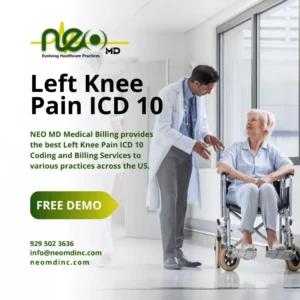Left knee pain can be a debilitating condition that affects individuals of all ages and backgrounds. When it comes to medical coding and documentation, the International Classification of Diseases, Tenth Revision (ICD-10) provides a standardized system for classifying and coding different health conditions. In this comprehensive blog post, we will delve into the world of left knee pain ICD 10 codes and explore the clinical indications associated with this condition.
By understanding the intricacies of coding and clinical indications, healthcare professionals can effectively diagnose and treat left knee pain, leading to improved patient outcomes.
-
Understanding ICD-10:
-
What is ICD-10?
ICD-10 is an internationally recognized coding system developed by the World Health Organization (WHO) for classifying diseases, injuries, and health conditions. It offers a comprehensive set of codes that enable healthcare professionals to accurately document and track various medical conditions.
-
Importance of ICD-10 Coding:
Accurate coding of left knee pain ICD 10 is crucial for several reasons. It ensures proper documentation, facilitates communication between healthcare providers, supports medical research, and enables effective billing and reimbursement processes.
-
Left Knee Pain ICD 10 Codes:
-
Common ICD-10 Codes for Left Knee Pain:
M25.561 – Pain in the left knee
M25.562 – Stiffness of left knee
M25.569 – Other specified joint disorders of the left knee
-
Subcategories and Extensions:
The ICD-10 coding system provides subcategories and extensions for left knee pain, allowing for detailed documentation and better patient care. These subcategories enable healthcare professionals to specify the condition’s nature, severity, and specific characteristics, leading to more targeted treatment approaches.
III. Clinical Indications:
-
Common Causes of Left Knee Pain ICD 10:
Left knee pain can have various underlying causes, including:
Osteoarthritis: This degenerative joint disease occurs when the cartilage that cushions the knee joint wears down over time, leading to pain, stiffness, and limited range of motion.
Rheumatoid Arthritis: An autoimmune disorder where the body’s immune system mistakenly attacks the joints, causing inflammation, pain, and swelling in the knee.
Meniscus Tear: A tear in the rubbery C-shaped cartilage (meniscus) that acts as a shock absorber between the thighbone and shinbone. It can occur due to sudden twisting or overuse, causing pain, swelling, and difficulty moving the knee.
Ligament Injuries: Injuries to the ligaments supporting the knee joint, such as the anterior cruciate ligament (ACL) or medial collateral ligament (MCL), can result from sudden stops, changes in direction, or direct impact. Ligament injuries often cause pain, swelling, and instability.
Patellar Tendonitis: Also known as jumper’s knee, it is an overuse injury characterized by inflammation of the tendon connecting the kneecap (patella) to the shinbone (tibia). It causes pain, tenderness, and difficulty with jumping or kneeling activities.
Bursitis: Inflammation of the bursae, small fluid-filled sacs that cushion the knee joint. Bursitis can occur due to repetitive motion, prolonged kneeling, or direct trauma, resulting in pain, swelling, and warmth around the knee.
Patellofemoral Pain Syndrome: This condition involves pain and discomfort around or behind the kneecap (patella) and is often caused by muscle imbalances, structural abnormalities, or overuse.
-
Diagnostic Procedures and Tests:
To accurately diagnose knee pain, healthcare professionals may use various diagnostic procedures and tests for documenting Left Knee Pain ICD 10 Code, including:
Physical Examination: A thorough examination of the knee joint, assessing range of motion, stability, tenderness, and swelling.
X-rays: Imaging technique used to evaluate the bony structures of the knee, identifying fractures, arthritis, or joint misalignment.
Magnetic Resonance Imaging (MRI): Provides detailed images of the soft tissues, ligaments, cartilage, and tendons, aiding in the diagnosis of ligament tears, meniscus injuries, and other soft tissue abnormalities.
Arthroscopy: A minimally invasive procedure that utilizes a small camera to visualize and assess the internal structures of the knee joint, facilitating diagnosis and potentially enabling surgical interventions.
Blood Tests: May be performed to identify underlying causes of knee pain, such as autoimmune disorders or infections.
-
Treatment Options:
The treatment approach for left knee pain depends on the underlying cause and the severity of the condition. Common treatment options include:
Conservative Measures:
- Rest, ice, compression, and elevation (RICE): These measures help reduce pain, inflammation, and swelling.
- Physical therapy: Targeted exercises and stretches to improve knee strength, flexibility, and stability.
- non-steroidal anti-inflammatory drugs (NSAIDs): Medications such as ibuprofen or naproxen for pain relief and inflammation reduction.
- Assistive devices: Knee braces, crutches, or orthotic inserts to provide support and promote healing.

Left Knee Pain ICD 10
Medications: (Left Knee Pain ICD 10)
- Analgesics: Pain-relieving medications to manage pain.
- Corticosteroid injections: Injections of anti-inflammatory medication into the knee joint to reduce pain and inflammation.
- Hyaluronic acid injections: Injections of a lubricating substance into the knee joint to improve joint movement and reduce pain.
Surgical Interventions:
- Arthroscopy: Surgical repair or removal of damaged cartilage, ligaments, or loose fragments within the knee joint.
- Partial or Total Knee Replacement: In severe cases, where conservative treatments fail to provide relief, surgical replacement of damaged knee joint surfaces with artificial implants may be considered.
- Coding Tips and Best Practices:
- Detailed Documentation:
Accurate and detailed documentation is essential for selecting the appropriate left knee pain ICD 10 Code. Healthcare providers should record the specifics of the condition, including location, severity, duration, aggravating or alleviating factors, functional limitations, and any associated symptoms or conditions.
-
Familiarity with ICD-10 Updates:
Staying updated with changes and additions to the ICD-10 coding system is vital. Regularly reviewing the latest coding guidelines and updates ensures accurate coding and prevents any potential coding errors or inaccuracies.
-
Collaboration with Coding Professionals:
Collaborating with coding professionals, such as certified medical coders, can greatly assist healthcare providers in accurate coding and documentation. These experts possess in-depth knowledge of ICD-10 and can help select the most appropriate codes for left knee pain based on the clinical indications provided.
Our standouts as the Best Medical Billing Company?
NEO MD stood best among competitors’ Revenue Cycle Management Companies due to the following cores;
- Our experts work hard to reduce your front-end denials by 20%.
- Claim first level acceptance ratio; 95-97%
- Refunds adjustment and Payment posting to improve the cash flow.
- Offer Services that are easily scalable at all times.
- Offer internal Medical Billing audits to uncover loopholes
- Out of Network Negotiations.
- Offer Provider & Staff Productivity Analysis
- Offering state-of-the-art medical billing services for small practices, medium-sized, and large ones.
- Use the latest technology and tools.
- Improve RCM system efficiency with a robust credentialing team.
- Provide fortnightly financial and practice overviews
- Deliver customized Revenue Cycle Management Services to unearth operation shortcomings.
You can rely on NEO MD as a trusted partner who values your success as much as you do. They go the extra mile to ensure that you clearly understand your practice’s financial performance, helping you make informed decisions for continued growth and success.
Conclusion:
Accurate and detailed coding of left knee pain ICD 10 is essential for effective patient care, communication among healthcare providers, and billing processes. By understanding the various ICD-10 codes and clinical indications associated with left knee pain, healthcare professionals can ensure precise documentation, leading to improved patient outcomes. With proper coding and comprehensive clinical information, accurate diagnoses and appropriate treatment can be provided to individuals experiencing slot server thailand left knee pain, ultimately resulting in a better quality of life and enhanced healthcare delivery.





